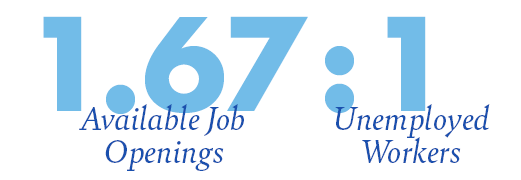April Economic Commentary: Labor Market Remains Most Resilient Part of Today’s Economy
The past month has seen further slowing in most economic activity reports. Inflation is improving but is still elevated, and there is ongoing evaluation of the fallout from the collapses of Silicon Valley Bank and Signature Bank that occurred in the first part of March. The quick responses by the Fed, the FDIC, and the Treasury have, for the time being, helped ease the panic that ensued following the bank failures. The Fed’s job has become more challenging, however, as it now must address both inflation concerns and bank solvency matters.
The stress in the banking sector will only increase the tightening of credit conditions that had started even before Silicon Valley Bank and Signature Bank failed. Lending standards for commercial and industrial loans, and commercial real estate loans had already tightened to levels that historically were associated with economic contractions. The impact is likely to be most evident in small and midsize banks as they hold nearly 70 percent of all commercial real estate loans. This is important to monitor as these are the banks that play an important role in the financing of small businesses. The next few months will provide better color as credit tightening impacts everything from capital spending plans to labor demand
Consumer Metrics
Looking at recent reports, the Consumer Price Index for February was released just days after the onset of the banking crisis. Although the year-over-year rate of headline inflation is improving – dropping from 6.4 percent in January to 6.0 percent in February – the core inflation index, which strips out food and energy prices, recorded a stronger than expected monthly reading resulting in the year-over-year core CPI only falling from 5.6 percent in January to 5.5 percent in February. The inflation situation was further complicated recently by OPEC’s announcement on April 3 to cut oil production by 1.2 million barrels per day.
Improvement in inflation is expected to continue, but the rate of improvement appears to be slowing, and measures of inflation remain stubbornly above the Fed’s 2.0 percent target.
Both retail sales and overall personal consumption expenditures in February eased from their strong January readings that were attributed to the unseasonably warm weather at the start of the year. Consumers have become more price conscious but are still willing to spend.
Leading Economic Indicators have now declined for 11 consecutive months and continue to forecast a slowing in the economy. Such a string of declining readings has always been an indication of an existing or upcoming contraction in the economy.
The ISM manufacturing survey index for March fell to a new low for this cycle. It has indicated contraction in the manufacturing sector for five consecutive months driven by seven consecutive months of contracting new orders and a declining order backlog. This survey also recorded a three-year low in its employment index.
The Labor Market
March’s establishment employment report showed the smallest monthly gain since December 2020 with non-farm payrolls increasing by 236,000. The average weekly hours worked is at the lowest level of the past year, and year-over-year average hourly earnings growth is at 4.2 percent – the slowest since June 2021. Additionally, the jobs opening report, released prior to the employment report, showed another drop in job openings suggesting that labor market conditions are loosening. There are now 1.67 job openings for every unemployed worker, which is the lowest ratio in 15 months.
Providing a different view of the jobs market, the household survey – which is used to calculate the unemployment rate – saw a stronger increase in jobs of 577,000 with the labor force increasing by 480,000. This resulted in the unemployment rate declining to 3.5 percent from 3.6 percent in February. In short, the labor market continues to be the most resilient part of the economy, even as some metrics indicate some easing in the demand for labor.
Interest Rates & The Fed
Amid everything else in March, the Fed held their scheduled Federal Open Market Committee (FOMC) meeting on March 21 and 22. The target range for the Fed Funds rate was increased by 0.25 percent to 4.75 to 5.00 percent. Taken by themselves, the current elevated inflation readings would likely keep the Fed on a clear path of increasing interest rates, but following the meeting, Chair Powell acknowledged that the potential impact of the banking crisis may effectively have the same impact on credit conditions as would increases in the Fed Funds rate. Consequently, the official statement from the Fed said, “some additional policy firming may be appropriate.” Powell also said that no members of the FOMC saw interest rate cuts as likely this year.
Despite Powell’s rhetoric, market expectations are now looking for possibly one more increase of 0.25 percent at the May 2 and 3 FOMC meeting, with two or three interest rate reductions by the end of the year, which could begin as early as the mid-September FOMC meeting.
Read More
Insights
Research to help you make knowledgeable investment decisions
